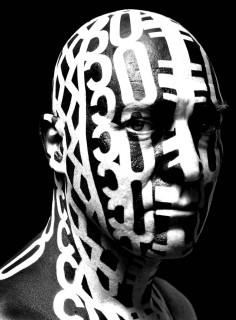kendell geers
fuckface

source: hausderkunstde
Kendell Geers, born in 1968 in South Africa, uses various media such as installation, drawing, video, performance, and photography. He gained international recognition through his participation in Documenta 11 (2002) and his active global exhibition activity.
His life and work can be divided into two decade-long periods whose trajectories and developments are explored in this exhibition. The first political phase runs from 1988 to 2000, during which time the artist, a white South African, explored the moral and ethical contradictions of the apartheid system through his practice. Geers developed a visual vocabulary characterized by provocation as well as humor by using found objects such as barbed wire or glass shards. By appropriating historical events and ideas, he focused on questions of relationship between individual and society. It was in this context that Geers changed his date of birth to May 1968, the start of the student and civil revolution, and joined every political party in the period before South Africa’s first democratic elections, from the extreme right-wing to the Communist party. In this way, he expressed his doubts about the fetishization of party politics.
Initiated by his move to Brussels in 2000, his later European period is now characterized by a more poetic aesthetic. Here, Geers transferred his incendiary practice into a postcolonial and increasingly global context, suggesting more universal themes like terrorism, spirituality, and mortality. As such, the artist’s life and work can be said to constitute a living archive comprised of political events, photographs, letters, and literary texts that serve as a source of inspiration and represent a continuation of his oeuvre.
The exhibition has been generously supported by Galleria Continua, San Gimignano / Beijing / Le Moulin; Goodman Gallery, Johannesburg / Cape Town; Galerie Rodolphe Janssen, Brussels; Stephen Friedman Gallery, London.
.
.
.
.
.
.
.
source: theprogressoflove
b. 1968, Johannesburg
In the late 1980s, Kendell Geers was exiled from South Africa when he refused to join the South African Defense Force. During this period, he lived in the United Kingdom and New York City, returning in 1990 after the release of Nelson Mandela and other political prisoners. He currently lives and works in Brussels.
Deeply influenced by his experiences growing up during apartheid, Geers employs strategies of provocation and disruption to question the history, aftermath, and implications of the period. Treating nothing as sacred, he frequently targets objects and images from art history and pop culture as his work confronts notions of power, convention, and perception, invoking individual and collective agency. His works are both physically and visually forceful, and he uses colors and materials that signal danger, such as sirens, broken glass, and barbed wire, to draw attention to the pervasiveness and banality of violence. Geers also uses words as a means to explore the coding and reinterpretation of language and its meaning.
Geers’s work has been shown in numerous international group exhibitions, including Néon, Who’s afraid of red, yellow, and blue?, la maison rouge, Paris (2012); and in the Dublin Contemporary (2011), 29th São Paulo Biennial (2010), 52nd Venice Biennale (2007), and Documenta 11, Kassel, Germany (2002). Solo shows include Kendell Geers: Songs of Innocence and Experience and Kendell Geers: Third World Disorder, Goodman Gallery, Cape Town (2012, 2010); Kendell Geers: Handgrenades From My Heart, Galerie Rodolphe Janssen, Brussels (2010); A Guest + A Host = A Ghost, Stephen Friedman Gallery, London (2009); Irrespektiv, Stedelijk Museum voor Actuele Kunst, Ghent, Belgium (2007, traveled); and The Prodigal Son, Goodman Gallery, Johannesburg (2003).
.
.
.
.
.
.
.
source: lespressesdureel
lespressesdureel
Né à Johannesburg, Kendell Geers a choisi de falsifier sa date de naissance devenue l’année 1968, marquant ainsi son entrée dans la vie par un événement révolutionnaire. Exclut d’Afrique du Sud suite à son refus d’effectuer son service militaire sous le régime de l’Apartheid, il vit et travaille à Londres, Leipzig, Vienne et New York.

